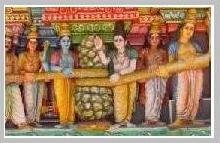 Q. How does meat consumption contribute to rain forest depletion?
Q. How does meat consumption contribute to rain forest depletion?A. The United States imports roughly 200 million pounds of beef from Central America every year. Aside from the fuel used in transport, grazing land is needed for all of these animals.
Q. Where does all that land come from in a densely forested region?
The answer: from clear-cutting forests and rain forest. A Smithsonian study estimates that the necessity for more grazing land means that every minute of every day, a land area equivalent to seven football fields is destroyed in the Amazon basin.
For each hamburger that originated from animals raised on rain forest land, approximately 55 square feet of forest have been destroyed. And its not just the rain forest. In the United States, more than 260 million acres of forest have been clear-cut for animal agriculture. With increased per capita meat consumption, and an ever growing population, we can only expect to see more deforestation in the future. No forest No rain.
Q. How does eating meat affect water usage, water pollution and the ocean?
A. The global effects of meat consumption don’t stop on land. Agriculture also requires water consumption, and animal agriculture is no exception. Animal production consumes an amount of water roughly equivalent to all other uses of water in the United States combined. Besides grains, animals need water to survive and grow until they are slaughtered. One pound of beef requires an input of approximately 2500 gallons of water, whereas a pound of soy requires 250 gallons of water and a pound of wheat only 25 gallons. Meat production is inefficient as it requires the consumption of an extensive amount of resources over many months and years before becoming a usable food product. With the water used to produce a single hamburger, you could take a luxurious shower every day for two and a half weeks.
Even the EPA identifies agriculture as a major water pollutant.
Agricultural pesticides and nitrates used in fertilizers and manures seep into our groundwater, eventually spilling out into the oceans creating so-called “dead zones” (expansive areas so toxic that neither plant nor animal life can survive) viewable from space in places like the Gulf of Mexico where the Mississippi spills out into the sea. Besides the chemicals used in cultivation, accidental pollution though chemical spills and manure dumps are an ongoing source of water pollution from feedlots. The manure created from the billions of animals killed for food has to go somewhere, and often, it ends up in rivers and streams, killing millions of fish in one fell swoop.
Help your environment ,your fellow human beings, animals, plants, lakes and oceans by not eating meat.


















